Many organizations invest in idea-generation processes to harness the creative thinking of their entire workforce and foster innovative solutions.
While this initiative is well-intentioned and aims to build a thriving culture of innovation, we've noticed common mistakes made by organizations hinder idea generation.
Specifically, many organizations overlook the importance of continuously educating and updating employees about current priorities when soliciting ideas.
Instead, they might use a generic web form or Slack channel, asking employees to submit ideas. Since employees have no guidance on the ideas needed, they tend to submit ideas specific to their day-to-day tasks and responsibilities. This results in innovation managers primarily collecting ideas that don’t address the organization’s priorities.
With over a decade consulting experience with companies, universities, and government institutions, we’ve identified key steps for an effective idea-generation process:
Use challenges to communicate priorities: Educate employees on the types of ideas needed through innovation challenges, ensuring submissions align with organizational goals.
Encourage collaboration: Allow employees to view and improve each other's ideas, leading to higher-quality submissions for innovation managers.
Provide feedback: Update employees on the status of their ideas to maintain engagement and prevent them from feeling "left in the dark."
Reward contributions: Recognize and reward employees for their efforts to keep them motivated and engaged. Brainstorming, researching, and iterating on ideas often demands employees to shift their focus from their core responsibilities for hours on end.
This article delves into these steps and demonstrates how our innovation management software, InnovationCast, facilitates this process with targeted ideation features.
To learn more about how InnovationCast can help you collect high-quality ideas, book a free demo with our team.
Use Innovation Challenges to Collect Ideas Around the Organization’s Priorities
As we mentioned earlier, many organizations establish an innovation or idea-generation process by setting up an open call for ideas, where employees can submit any idea that comes to mind. However, this makes it challenging to gather ideas that align with organizational priorities because employees have no guidance on what ideas are required.
For example, if a retail company aims to increase sign-ups for its customer loyalty program, it's unlikely to collect relevant ideas if employees aren’t informed about this priority.
Additionally, open calls for ideas usually don't have deadlines. This reduces the sense of urgency for employees to submit their ideas quickly, thus making it difficult to source ideas on pressing topics.
Instead, we’ve found that using Innovation Challenges works well for collecting ideas.
Innovation Challenges invite employees (and external participants like customers and partners) to submit ideas on specific priorities before a deadline. These challenges clarify which ideas are important to the organization and focus submissions on these priorities.
Innovation managers can add detailed descriptions and additional resources to each challenge to help employees grasp the nuances of the priority.
Based on our experience, the most successful challenges typically include:
Reasoning: Explains why the challenge is important.
Desired results: Defines the specific problem to solve or goal to achieve.
Evaluation criteria: Outlines the criteria for assessing and selecting ideas.
Restrictions: Details any constraints, such as implementation time and costs.
Target audience: Describes who will benefit from the solution.
Employees can review these resources to grasp the nuances of the topic before submitting ideas, which helps innovation managers collect higher-quality submissions.
Additionally, deadlines for challenges create a sense of urgency, encouraging employees to submit thoughtful ideas.
Read more: 6 Innovation Challenge Software (2024 Comparison)
How InnovationCast Supports Innovation Challenges
To address this need, we designed InnovationCast with challenges in mind.
Innovation managers can post challenges related to organizational priorities set by top management and attach detailed information to each posting to help employees understand them better. This might include market research data for a new product launch or customer feedback interviews for continuous improvements to existing products.

Innovation managers can then create submission forms tailored to each type of idea they want to collect (e.g., product ideas, business model ideas, and continuous improvement ideas, each with their own dedicated form). These forms can include questions asking employees to specify who their idea would benefit, how long implementation might take, and any other relevant questions innovation managers wish to include.
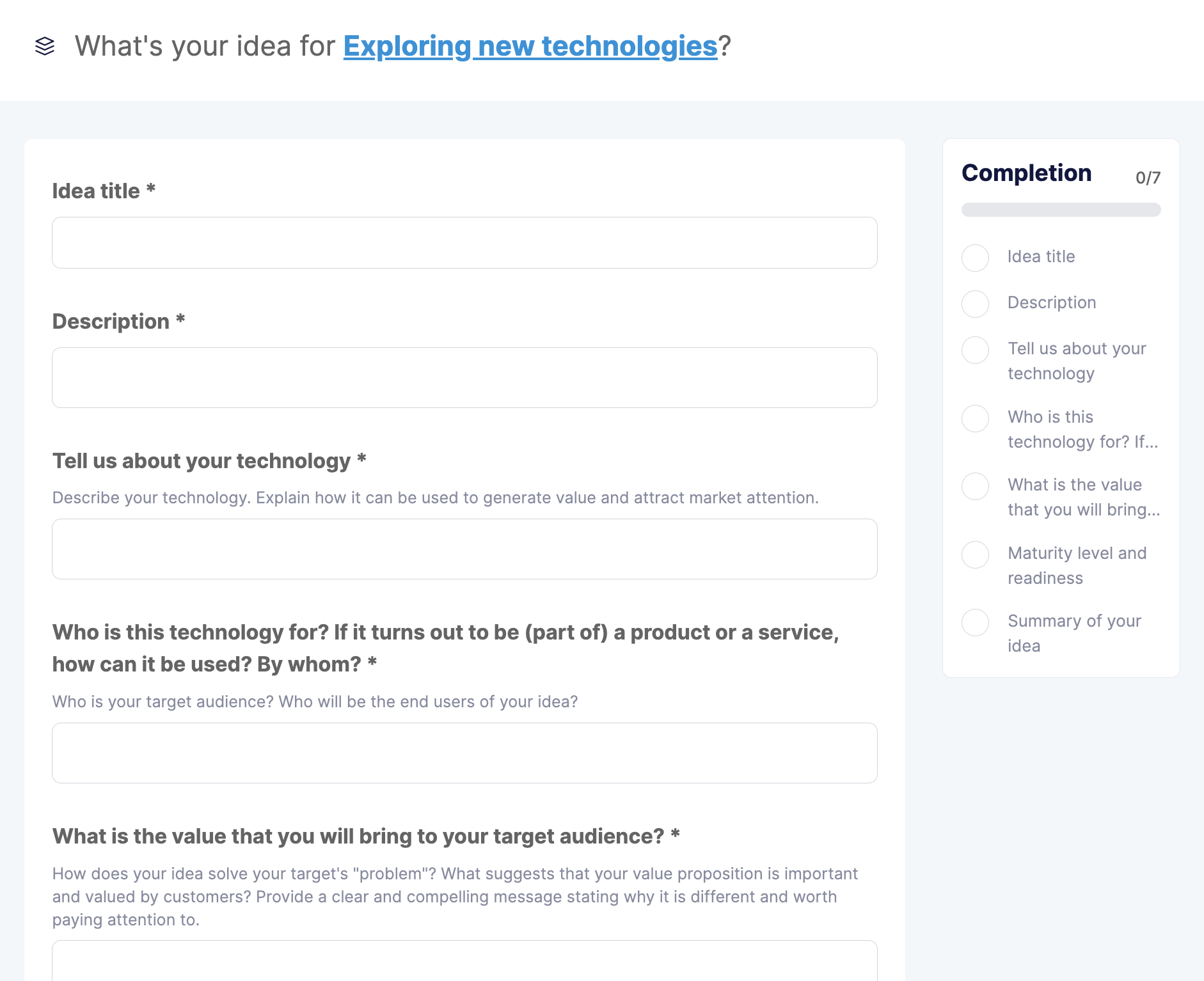
Lastly, innovation managers can set deadlines for each challenge, which encourages timely employee involvement.
Ideas Should Be Tied to Organizational Priorities
While we typically suggest using time-bound challenges to collect ideas, it’s still important to allow employees to submit ideas at any time. This ensures they have an outlet to share new opportunities they may identify outside of formal challenge periods.
For example, if an employee discovers an area for improvement — such as the accounting team being able to reduce payroll processing time by 50% using new software — they can bring it to the accounting manager's attention, even if there isn’t an active challenge related to payroll.
The key to successful open idea submissions is to have employees categorize their ideas into broader topics of interest. If an idea doesn’t fit into one of these topics, it cannot be submitted. This ensures that all ideas remain aligned with the organization's overall goals.
Category-Based “Always On” Idea Collection: Collect Ideas 24/7
We added an idea collection feature called “Always On” to InnovationCast to help innovation managers collect ideas at any time.
However, instead of being an open call for employees to submit any idea, employees must sort their idea into predefined categories established by the innovation department. This is a small yet important feature because it ensures that all submissions are still tied to more general, less urgent priorities the organization is trying to address.
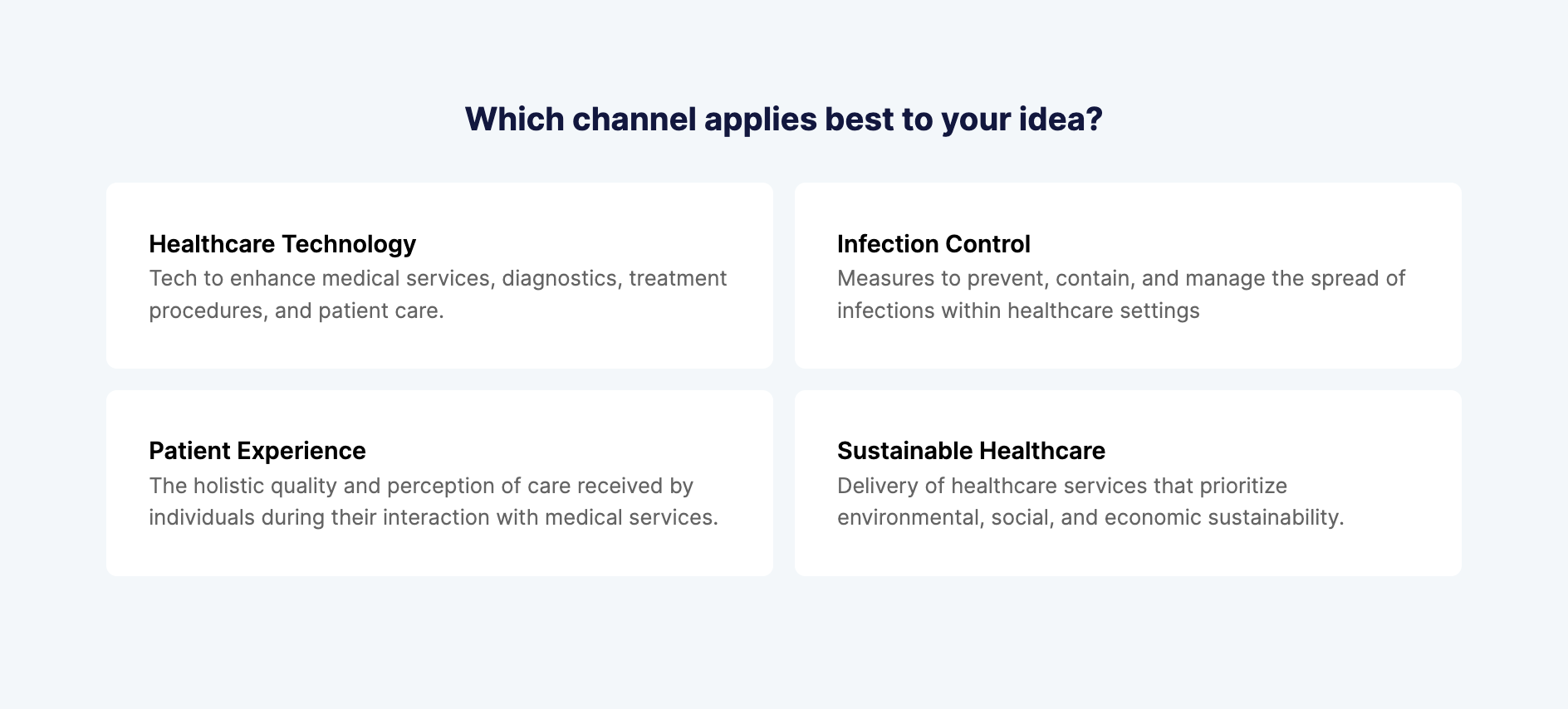
For instance, in the screenshot above, we can see how an innovation department inside a healthcare company requires their employees to sort their idea into either patient experiences, new healthcare technologies, infection control, or sustainable healthcare.
Encourage Employees to Collaborate on Idea Improvement
An essential, yet often overlooked, aspect of effective idea generation is that the process doesn’t end with idea submission. In our experience, it’s rare for someone to submit a flawless idea that requires no refinement. There are typically aspects that need to be addressed before innovation managers can move an idea to validation and implementation.
This is where the idea improvement step comes in, and we’ve found that it works best done when integrated into the idea generation phase. Once ideas are submitted, innovation managers should allow employees — and potentially outside experts, if there are no IP concerns — to view the details and suggest improvements. By identifying weaknesses, the original authors can collaborate with colleagues to refine their ideas.
A common mistake organizations make during this stage is limiting employees to simply voting on ideas. Employees can give one to five stars or perhaps a thumbs up or down, but there’s no opportunity for them to improve the idea alongside the original authors.
That’s why we designed InnovationCast with features that actively promote idea improvement.
InnovationCast Helps Organizations Crowdsource Idea Improvement
Whenever someone shares an idea, InnovationCast displays it on the activity feed for others to see. When employees, managers, or stakeholders log in, they can see all idea submissions and are encouraged to share their thoughts by saying if the idea “Looks Good,” “Not So Good,” or they’re “Undecided.”
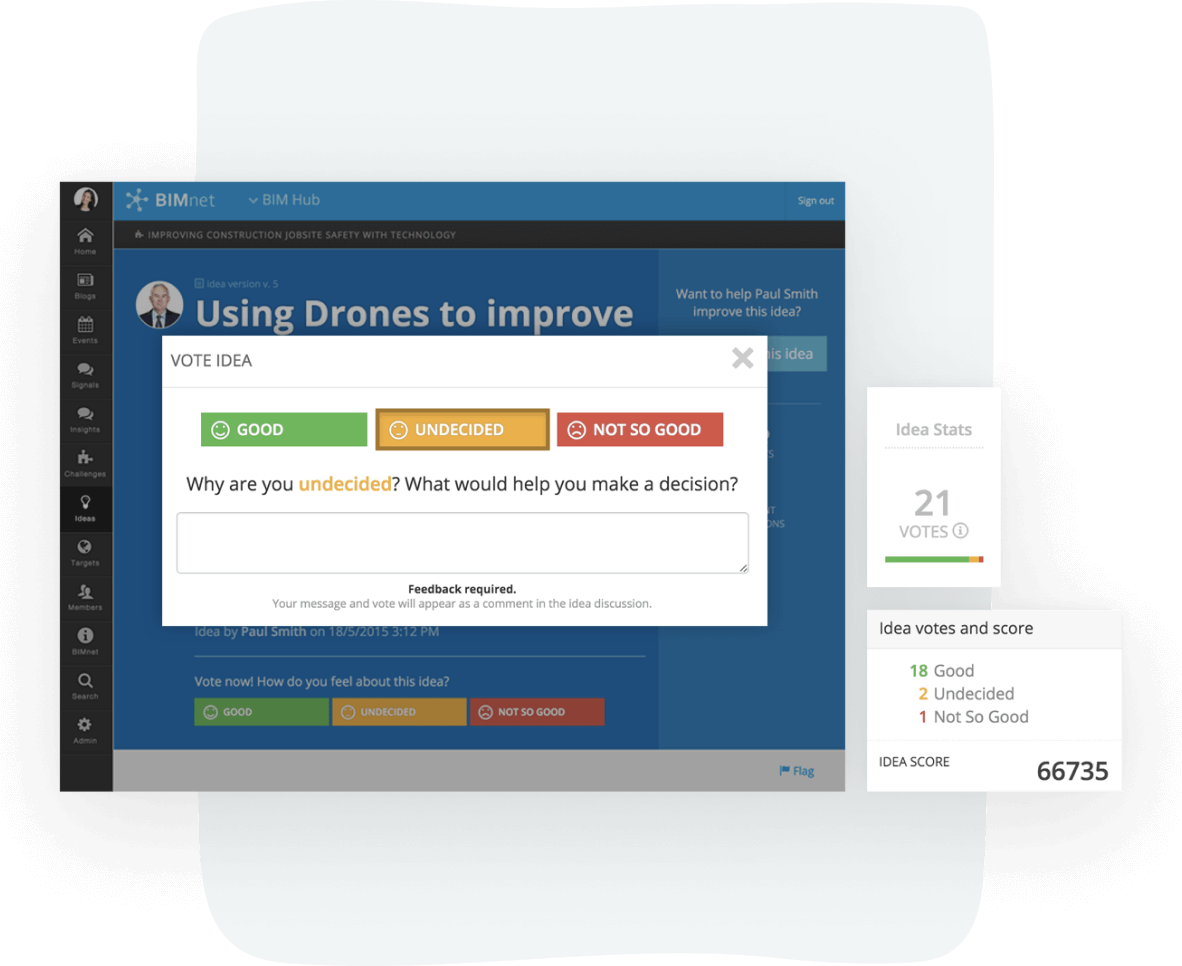
Most importantly, instead of simply voting on an idea, InnovationCast encourages users to provide the original author with constructive advice for improvement. Users are prompted to explain the reasoning behind their vote — why they think the idea is good or not so good — and offer suggestions for how it can be refined. Then, voters and original authors can collaborate and use brainstorming techniques such as reverse thinking and storyboarding to improve the idea.
In our experience, this step is equally important as collecting ideas because it gets individuals from different perspectives within the company (marketing, finance, R&D, etc.) helping authors improve their ideas. As a result, innovation managers receive more actionable submissions.
Let Employees to Follow the Status of Their Ideas
Employees invest a lot of time into brainstorming and researching ideas. If they can’t see what happens to their submissions, they may feel “left out” and become discouraged from continuing to contribute. For instance, if an employee’s idea was good enough to be turned into a real-world innovation, they might not know about it.
Instead, organizations should make employees feel involved by letting them see how their ideas are refined, validated, and launched. If an employee’s idea is saving the organization a certain amount of money, for example, they should be informed about it. This shows employees that their hard work is making a difference and increases the likelihood that they will submit ideas in the future.
However, providing employees with this level of transparency requires an innovation management system that supports the entire lifecycle of an idea, from collection to implementation. If idea collection is treated like a black box activity, where only a few stakeholders can view submissions, employees can’t see their ideas develop.
Our “Innovation Hub” Gives Employees Visibility into Idea Progress
When designing InnovationCast, we paid particular attention to providing original authors with insight into their idea's progress from collection to implementation. After launch, they can also track its impact on the organization.
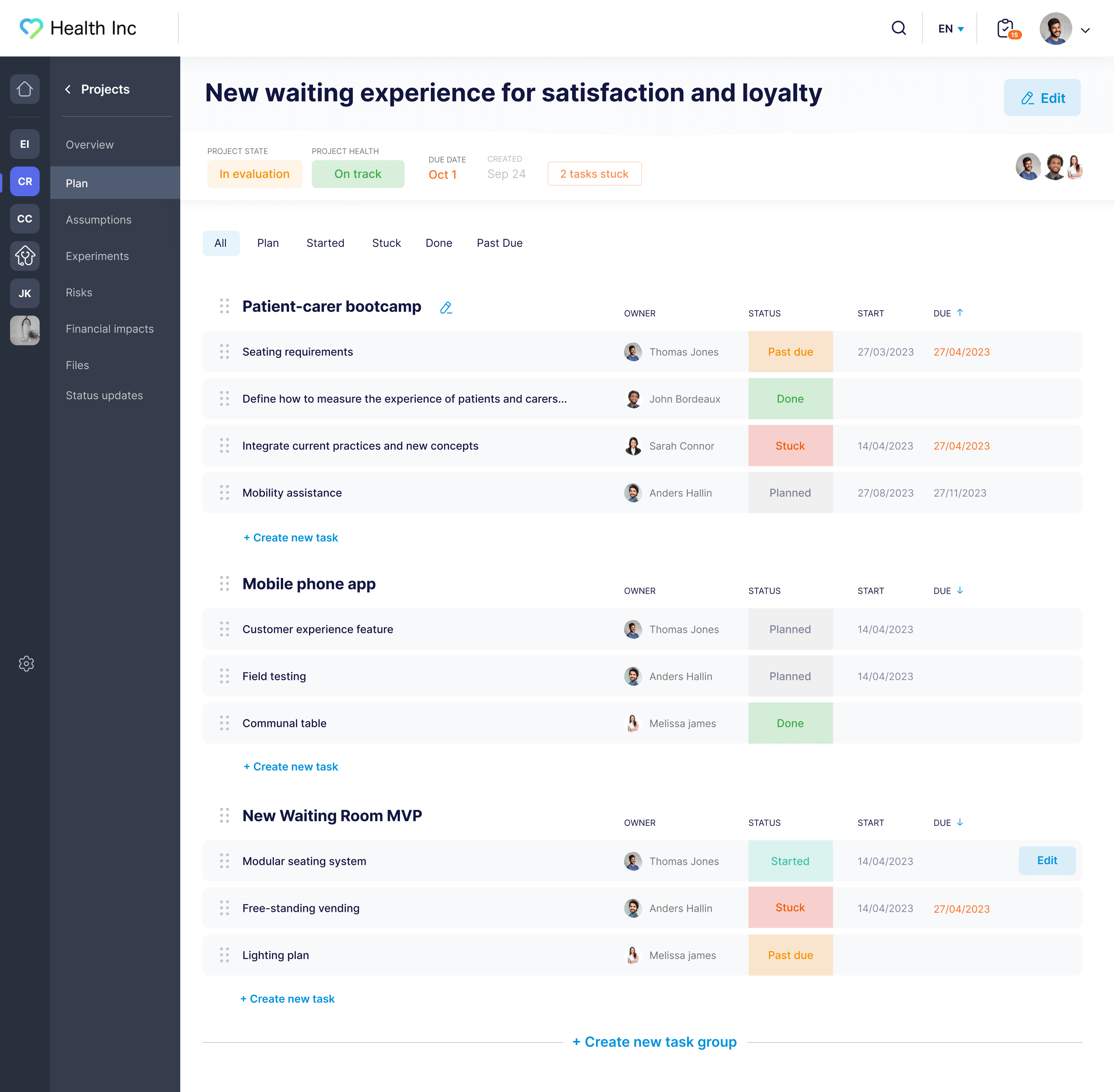
When idea authors log into InnovationCast, they can:
View visual representations of their submitted ideas and track their lifecycle status, such as assessment by stakeholders, MVP development by the product team, or full product launch.
See the experiments being conducted to evaluate their idea.
Opt to receive email notifications whenever something happens to their idea, whether that’s a colleague giving feedback or a stakeholder moving it forward to validation.
Follow the creative process of their colleagues’ ideas and receive periodic updates on their progress.
Reward Employees for Their Hard Work
Another crucial aspect of an effective idea-generation process is rewarding employees for high-quality ideas and feedback. This keeps them engaged with new challenges and motivated to contribute. We strongly recommend establishing a rewards program that offers monetary or non-monetary rewards based on the quality of ideas.
The key is to reward employees for high-quality participation, not just the volume of ideas. Many organizations make the mistake of rewarding a large number of submissions without assessing their merit, which fails to incentivize thorough research and thoughtful development.
Instead, prioritize quality over quantity. For example, set milestones based on the quality of work, such as rewarding an employee who submits 10 ideas that are assessed for validation.
InnovationCast Enhances Employee Rewards with Its Badges & Rewards System
We designed InnovationCast with an employee badges and rewards program:
You can have rewards in place for employees who achieve certain milestones. Using the example above, if an employee submitted 10 ideas that were considered for validation, you could reward them with PTO, cash prizes, concert tickets, dinner, or any reward you choose.
You can establish a points system where employees receive a set number of points for performing specific actions or tasks. For instance, for every high-quality idea an employee submits, they could receive 10 points. Then, they can “save up” their points and redeem them for rewards.
If an employee submits a truly impactful idea that saved or made the company money, they can be rewarded with a percentage of the savings or earnings. In our experience, this method of rewarding employees usually has the most positive impact on engagement levels; however, it’s obviously not an option for every organization.
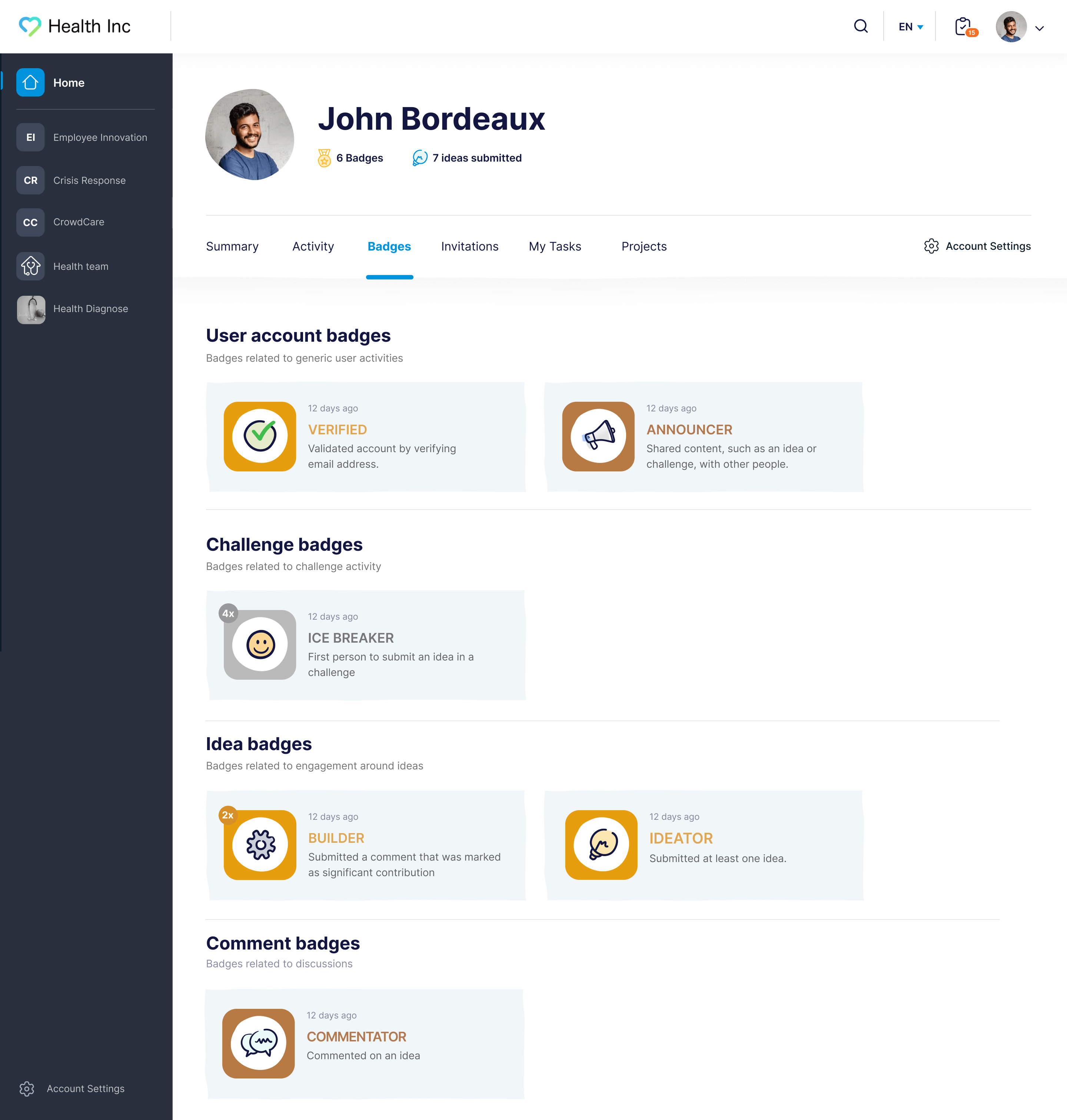
Read more: How to Build an Organization-Wide Employee Innovation Program
Encourage Employees to Share News & Insights
Not every employee has original ideas to share, but involving them in innovation efforts can provide valuable insights from a broader base. Encourage employees to share the latest industry news in a central repository, allowing everyone to stay informed and brainstorm its impact on the organization.
For example, if an employee at a tech company sees a social media post about a groundbreaking new product from a startup, they should be able to share it with the team. This can stimulate problem-solving and innovative thinking.
InnovationCast’s Signals & Scouting Feature Centralizes News Sharing
We added a Signals & Scouting feature to InnovationCast to help innovation managers stay informed about industry advancements.
Whenever a user encounters industry news that they think is important, they can share it through Signals, and these resources will appear on the InnovationCast dashboard for team members to see. This provides employees with an alternative way of sharing insights beyond typical idea submission.
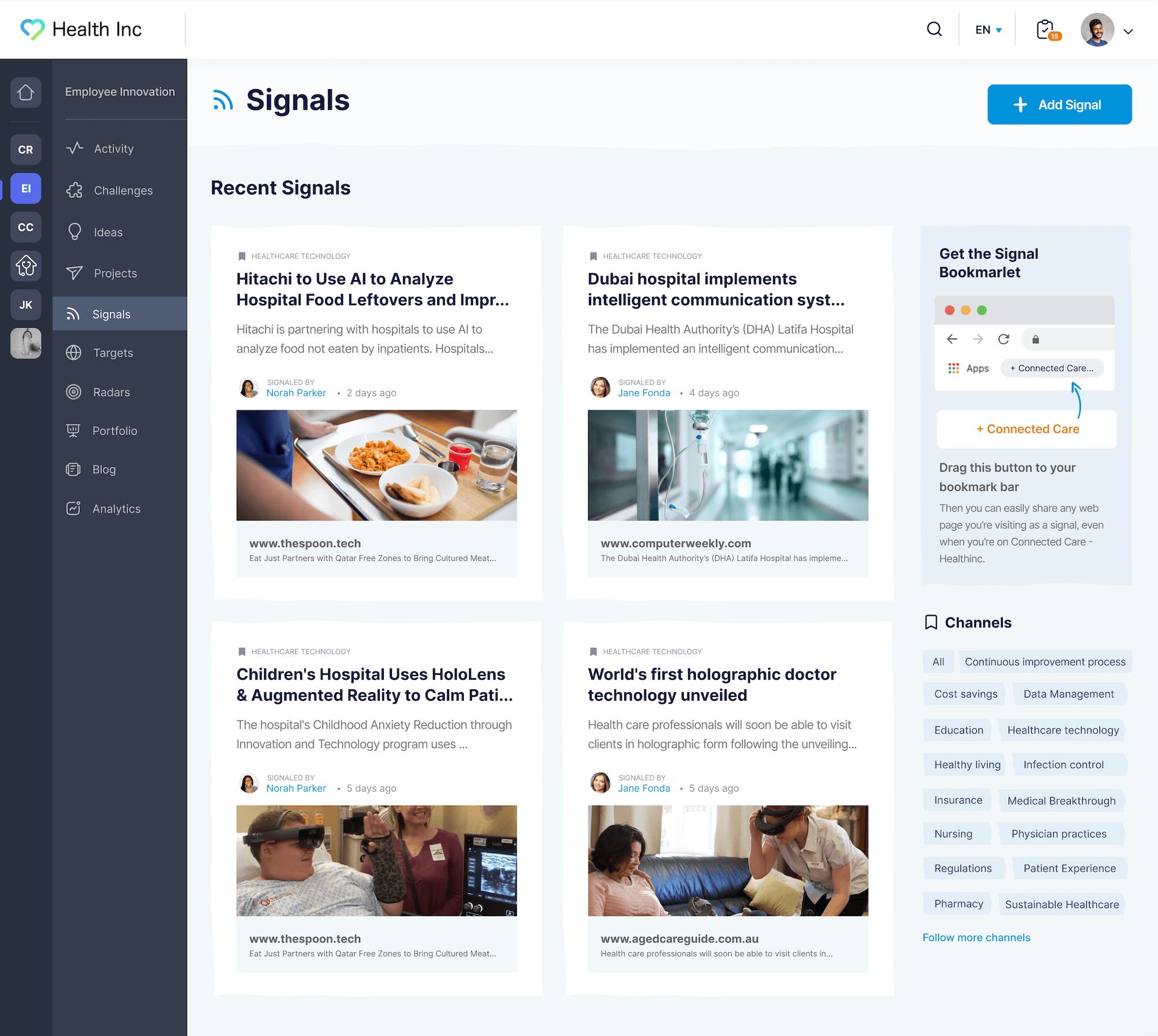
Additionally, when a user submits a Signal, InnovationCast asks them to sort their resources into channels, such as customer retention, new technologies, or competitor news. This ensures that all resources align with the business areas that innovation managers are prioritizing.
Keep Innovation Priorities Top of Mind for Employees
To keep employees focused on the organization’s innovation priorities and encourage idea submission, it’s crucial to send periodic email reminders.
InnovationCast supports this with custom email reminders and automation features. You can notify employees in real-time about new challenges, prompt them to submit innovative ideas, and automatically email inactive users.

In addition, we provide email templates with onboarding materials to train new employees on using InnovationCast, including responding to challenges, posting Signals, and providing quality feedback. This streamlines the onboarding process for you.
Read more: How to Encourage Innovation in the Workplace
Prioritize Idea Implementation Over Idea Generation
Even with idea generation methods like challenges to guide employees on the types of ideas needed and a centralized hub for improving existing ideas, problems can arise if there's no effective idea management process to ensure ideas are actually launched. Specifically:
Lack of follow-through: Some employees don’t see the progress on their ideas after submission. They’ve invested hours in brainstorming sessions and used various idea generation techniques such as mind mapping, role-playing, and brainwriting, only for stakeholders to not assess their ideas. This can lead to disengagement from innovation efforts.
Dormant ideas: Ideas can stagnate if the idea management process lacks clarity. Without defined criteria for assessment, validation processes, and risk evaluation, ideas remain inactive.
This is why we recommend organizations view idea generation as simply the first step to a successful innovation process. Once ideas are collected, there should be predefined criteria to assess ideas and the workflows to validate them before launch.
Further reading: How to Develop Innovation Processes to Launch New Ideas
Establish an Effective Ideation Process with InnovationCast
DHL, Novo Nordisk, ING, Delta Cafés, and multiple other companies have used InnovationCast to collect ideas from employees and develop them into creative solutions.
For example, DHL increased idea submissions by 67% in just four weeks using InnovationCast, which led to a 14% increase in implemented ideas.
To see how we can do something similar for your organization, book a free demo with our team.
Related reads:

